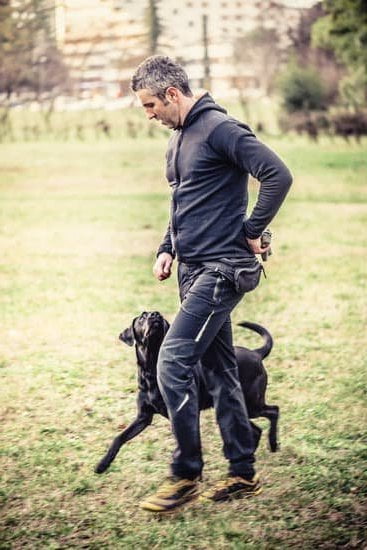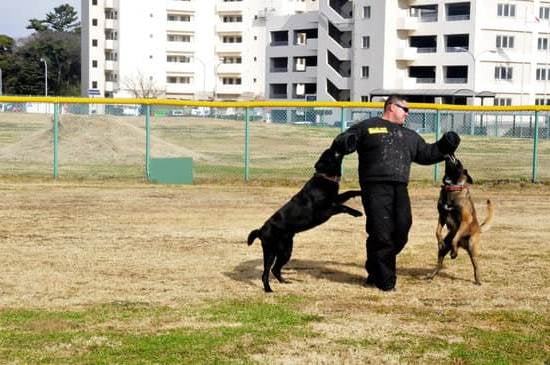Owning a well-behaved and obedient dog can greatly enhance the bond between you and your furry friend. But how do you go about training your dog in obedience? In this article, we will delve into the world of dog obedience training and provide you with essential tips and techniques to help you train your dog effectively.
Dog obedience training is not just about teaching your dog to follow commands; it goes much deeper than that. It is about establishing trust, improving communication, and nurturing a strong bond between you and your pet. Through obedience training, you can teach your dog how to behave properly in various situations and ensure their safety as well as the safety of those around them.
Having a well-trained dog also brings numerous benefits. A trained dog is more likely to be accepted in public places, making outings and social interactions easier. They are less likely to exhibit destructive or aggressive behavior and are better equipped to handle various environments. Obedience training also helps stimulate the mental faculties of your furry companion, keeping them engaged and satisfied.
In the following sections, we will explore the basics of dog obedience training, including understanding what it entails and the fundamental principles involved.
We will discuss how to set a conducive environment for training, establish a strong bond with your dog, teach basic commands such as sit, stay, and come, address problematic behaviors effectively, practice positive reinforcement techniques for rewarding good behavior, maintain ongoing training even after basic commands are learned, troubleshoot common challenges faced during obedience training, and recap key points before concluding.
So if you’re ready to embark on an exciting journey of bonding with your loyal companion while teaching them important life skills through obedience training, let’s dive into the details.
Understanding the Basics of Dog Obedience Training
Dog obedience training is a crucial aspect of responsible pet ownership. It not only ensures that your dog behaves well in various situations but also strengthens the bond between you and your furry friend. In this section, we will delve into what dog obedience training entails and discuss some fundamental principles and techniques used in training.
Dog obedience training involves teaching dogs to respond reliably and consistently to certain commands or cues. The goal is to establish communication between you and your dog so that they understand what is expected of them in different situations. Through training, dogs learn to obey commands such as sit, stay, come, lie down, heel, and more.
There are several fundamental principles and techniques used in dog obedience training. One key principle is positive reinforcement, which involves rewarding dogs for exhibiting desired behavior. Rewards can include treats, praise, toys, or any other form of positive stimuli that motivates your dog. Another principle is consistency; it is important to use the same command word or hand gesture each time you want your dog to perform a specific action.
When it comes to techniques, one commonly used method is lure-reward training. This involves using a treat or toy as a lure to guide the dog into performing the desired behavior while associating it with a specific command word. As the dog becomes familiar with the command, rewards can be gradually phased out.
Another technique is clicker training, which uses a small device called a clicker to mark desired behaviors instantly. This helps dogs understand exactly which actions earn them rewards. Clicker training can be particularly effective for shaping complex behaviors.
By understanding these basics of dog obedience training and applying them consistently, you can lay a solid foundation for successfully teaching your dog essential commands and behaviors. Remember that practice, patience, and positive reinforcement are key ingredients for successful dog obedience training.
| Principles | Techniques |
|---|---|
| Positive Reinforcement | Lure-Reward Training |
| Consistency | Clicker Training |
Preparing for Training
Creating a conducive training environment is crucial when it comes to dog obedience training. This section will provide tips and guidelines on how to set up the right environment to ensure successful training sessions with your dog.
One important aspect of setting the right environment is choosing an appropriate location. Ideally, you should start training in a quiet and familiar space where your dog feels comfortable and focused. This could be a room in your house or a quiet corner of your backyard. Minimize distractions as much as possible, especially in the beginning stages of training.
In addition to location, selecting the right tools and equipment is also essential for creating a suitable training environment. Some commonly used tools include:
- Treats: High-value treats can be used as rewards during training sessions to motivate your dog and reinforce positive behavior.
- Clicker: A clicker can be a useful tool for marking desired behaviors and signaling to your dog that they have done something correctly.
- Leash and collar or harness: These tools are helpful for teaching commands such as “stay” or “heel” where you need control over your dog’s movement.
It’s important to note that while selecting tools and equipment, you should consider the specific needs of your dog. For example, if you have a small breed, choose lightweight collars or harnesses that won’t weigh them down or cause discomfort.
By carefully selecting the location and using appropriate tools and equipment, you can create an optimal environment for effective obedience training with your dog.
| Tools | Description |
|---|---|
| Treats | High-value treats used as rewards during training sessions. |
| Clicker | A clicker used to mark desired behaviors and signal correctness to the dog. |
| Leash and collar or harness | Helpful for teaching commands like “stay” or “heel” where control over the dog’s movement is required. |
Establishing a Bond with Your Dog
Building a strong bond with your dog is an essential part of obedience training. This bond is built on trust, communication, and mutual understanding between you and your pet. When there is a strong bond, it becomes easier for your dog to understand and follow your commands, making the training process more effective and enjoyable for both of you.
To establish a bond with your dog, spend quality time together every day. Engage in activities that both you and your dog enjoy, such as playing fetch or going for walks. This will not only help create a positive association with training but also strengthen the emotional connection between you.
Communication is key in building a strong bond with your dog. Use clear and consistent verbal cues when giving commands. Also, pay attention to your body language as dogs are highly perceptive of nonverbal cues. Maintain a calm and confident demeanor during training sessions to set the tone for your dog’s behavior.
Another important aspect of building a bond with your dog is practicing positive reinforcement. Rewarding good behavior with treats, praise, or playtime reinforces the idea that obeying commands leads to positive outcomes. This strengthens the trust between you and your dog and motivates them to continue following instructions.
Remember that building a bond takes time, patience, and consistency. Don’t be discouraged if progress is slow at first; continue to invest in quality interactions with your pup both inside and outside of training sessions. With consistent effort, you will see improvements in their responsiveness to commands and overall obedience.
Teach Basic Commands
Teaching your dog basic commands is an essential part of obedience training. By teaching your dog commands like “sit,” “stay,” and “come,” you can establish a foundation for their overall obedience and ensure their safety in various situations. In this section, we will provide step-by-step instructions on how to teach these fundamental commands.
Teaching the “Sit” Command
- Start by holding a treat close to your dog’s nose and move it up, allowing their head to follow the treat while causing their bottom to lower naturally.
- Once they are in a sitting position, say the word “sit” clearly and give them the treat immediately.
- Repeat this process several times until your dog starts associating the command with the action of sitting.
- Gradually introduce hand signals along with the verbal command, such as raising your hand palm-upward when saying “sit”.
- Over time, begin phasing out the treats and relying solely on praise and hand signals to reinforce the behavior.
Reinforcing the “Stay” and “Come” Commands
- To teach your dog to stay, start by instructing them to sit or lie down.
- Once they are in a stationary position, use an open palm facing towards them and say “stay” confidently.
- Give them a few seconds of stillness while maintaining eye contact before offering praise or a treat.
- Gradually increase the time between giving the command and offering praise so that your dog learns patience while staying put.
- For teaching the “come” command, begin by attached a long leash or rope to your dog’s collar for added control during training sessions.
- Stand near your dog, crouch down slightly, call their name followed by the command “come,” and gently pull on the leash if needed to guide them towards you.
- Once they reach you, offer lots of praise and rewards to reinforce the desired behavior.
By consistently practicing these basic commands with positive reinforcement, your dog will become more responsive and obedient over time. Remember to keep training sessions short and fun to avoid overwhelming your dog. Celebrate their successes, work at their own pace, and always end each session on a positive note. With patience and consistency, you will be amazed at how quickly your dog picks up these essential commands.
Addressing Problematic Behaviors
One of the most important aspects of dog obedience training is addressing problematic behaviors. While it’s natural for dogs to exhibit certain behaviors, some can be undesirable or even dangerous if not corrected. Addressing these behaviors not only helps in creating a well-behaved and obedient dog, but also ensures the safety and happiness of both the dog and its owner.
To effectively address problematic behaviors, it is essential to first identify and understand common behavioral issues. From excessive barking to aggression towards humans or other animals, there are a variety of troublesome behaviors that may arise during training. By recognizing these behaviors, owners can work towards finding appropriate solutions and implementing effective strategies for correction.
When dealing with problematic behaviors, it is crucial to remember that punishment-based methods are not recommended. Instead, positive reinforcement techniques should be used to correct undesired behavior. This means rewarding the dog when they exhibit good behavior rather than punishing them for negative behavior. Positive reinforcement has been found to be more effective in training because it encourages dogs to repeat desirable actions by associating them with rewards such as treats, praises, or playtime.
To address problematic behaviors effectively, consistency and patience are key. It is important to establish clear boundaries and rules for your dog from the beginning and ensure everyone in the household follows them consistently. Additionally, using techniques like redirection or substitution can help redirect your dog’s attention from unwanted behavior towards more appropriate alternatives.
By addressing problematic behaviors early on in obedience training and using positive reinforcement techniques, owners can shape their dogs into well-mannered companions. However, it’s important to remember that each dog is unique and may require different approaches when addressing behavioral issues. Seeking professional help from a certified dog trainer or behaviorist may be beneficial in instances where specific concerns persist despite consistent efforts at correction.
Addressing problematic behaviors not only helps improve obedience but also strengthens the bond between the owner and their furry friend. By understanding and effectively addressing these behaviors, owners can create a harmonious living environment for both themselves and their dogs.
Practicing Positive Reinforcement
Positive reinforcement is a key component of dog obedience training. It involves rewarding your dog for exhibiting desired behaviors, which helps to strengthen their understanding and motivation to obey commands. By using positive reinforcement techniques, you can create a positive and enjoyable learning experience for your dog.
The Benefits of Positive Reinforcement
Using positive reinforcement in dog training has several advantages. Firstly, it enhances the bond between you and your furry companion. When you reward your dog with treats, praise, or playtime for following commands correctly, they begin to associate obedience with positive experiences and will be more eager to please you.
Positive reinforcement also boosts your dog’s confidence and self-esteem. By focusing on their successes rather than punishing failures, dogs become more willing to try new things and are less likely to fear making mistakes during training.
Additionally, positive reinforcement allows you to effectively communicate with your dog. Through consistent rewards for good behavior, dogs quickly learn what actions result in positive outcomes, making it easier for them to understand what is expected of them.
Effective Reward Systems
There are various types of rewards that you can use during obedience training. Food rewards are often effective as dogs are naturally inclined to seek food as a means of survival. Treats should be small and easy to consume quickly so that training sessions can flow smoothly.
Verbal praise is another powerful tool in positive reinforcement. Dogs respond well to hearing words such as “good boy” or “well done” in an upbeat and cheerful tone. The combination of verbal praise with physical affection like petting or gentle massages further reinforces the good behavior exhibited by your dog.
In addition to food treats and verbal praise, other forms of rewards may include access to toys or playtime activities that your dog enjoys. Each dog is unique, so it may take some trial and error to find out what motivates them the most.
Remember that consistency is essential when practicing positive reinforcement. Provide rewards each time your dog correctly follows a command to reinforce the desired behavior consistently. Over time, with patience and consistency, positive reinforcement will strengthen your dog’s training foundation and lead to lasting obedience.
Ongoing Training & Maintenance
Once your dog has mastered the basic commands, it’s important to continue their training in order to maintain obedience and further develop their skills. Ongoing training is key to ensuring that your dog remains well-behaved and responsive to commands. It also provides mental stimulation for your dog and strengthens the bond between you.
Continuing Education
Just like humans need continued education to stay sharp, dogs benefit from ongoing training as well. Once your dog has a solid foundation of basic commands, you can introduce more advanced commands or tricks to keep their mind engaged. Teaching your dog new skills or tasks not only provides mental stimulation but also helps prevent boredom, which can sometimes lead to destructive behavior.
Varying Environments
Training in different environments helps generalize the learned behaviors and ensures that your dog will respond regardless of the surroundings. Start by practicing commands in familiar places, such as your home or backyard, before gradually introducing distractions in public spaces like parks or streets. The goal is for your dog to obey regardless of the environment they’re in.
Maintaining Consistency
Consistency is crucial when it comes to maintaining obedience. Be sure to consistently reinforce good behavior with praise and rewards, while addressing any undesirable behaviors promptly and effectively. Set clear rules and expectations for your dog and stick to them consistently. Also, remember to practice the commands regularly to keep them fresh in your dog’s mind.
Advanced Training Techniques
As you progress with your ongoing training, you may want to explore more advanced techniques such as agility training or scent work. These activities provide mental and physical challenges for your dog while promoting bonding between you both. Advanced training can be a fun way for both you and your dog to continue learning new things together.
Challenging Your Dog
Always strive to challenge your dog’s skills and push their limits. As they become more proficient in basic obedience, gradually increase the difficulty level by adding distractions or extending the duration of commands. This not only strengthens their training but also ensures that they remain obedient in different situations.
By incorporating ongoing training into your routine and maintaining consistent expectations, you can ensure that your dog remains well-behaved and responsive throughout their life. Remember that training is a lifelong process, and by continuing to work with your dog, you’ll both reap the benefits of a strong canine-human bond built on trust, communication, and mutual understanding.
Troubleshooting Common Challenges
During the process of obedience training, dog owners may encounter various challenges that can make the training process difficult. It is important to address and overcome these challenges to ensure successful training and a well-behaved dog. By understanding common challenges and implementing effective solutions, dog owners can navigate through these obstacles and continue on the path towards a well-trained dog.
One common challenge that many dog owners face during obedience training is excessive barking. Dogs bark for various reasons, such as boredom, fear, or territorial behavior. To address this challenge, it is essential to identify the root cause of the barking and address it accordingly.
For example, if a dog barks due to boredom, providing mental stimulation through interactive toys or puzzle games can help alleviate this issue. Additionally, teaching the “quiet” command can be beneficial in teaching dogs when to stop barking on command.
Another challenge that dog owners may encounter is leash pulling during walks. Dogs naturally want to explore their surroundings and may try to pull ahead during walks, which can be frustrating for both the owner and the dog. One solution to this challenge is teaching loose leash walking techniques. This involves rewarding the dog for walking calmly by their side without pulling on the leash. Consistency and positive reinforcement are key in addressing this challenge.
Additionally, some dogs may display aggression towards people or other animals during obedience training. Aggression can stem from fear, territorial behavior, past experiences, or lack of socialization. It is crucial to work with a professional dog trainer or behaviorist in addressing aggression issues safely and effectively. They can provide guidance on desensitization techniques, counter-conditioning exercises, and other methods to manage aggressive behavior.
Incorporating these troubleshooting strategies into your obedience training routine will help you tackle common challenges effectively. Remember to always remain patient with your furry companion and seek professional advice if needed. With time, consistency, and positive reinforcement, you can overcome these challenges and ensure a successful training journey with your dog.
Conclusion
In conclusion, obedience training is essential for every dog owner who wants a well-behaved and happy canine companion. Throughout this article, we have emphasized the importance of obedience training and provided helpful tips and techniques to get started.
From understanding the basics of dog obedience training to establishing a bond with your dog, teaching basic commands, addressing problematic behaviors, practicing positive reinforcement, ongoing training and maintenance, and troubleshooting common challenges, we have covered several key aspects of successful obedience training.
By investing time and effort into obedience training, you are not only shaping your dog’s behavior but also enhancing the relationship between you and your furry friend. A well-trained dog brings numerous benefits such as safety, better control in public places, improved socialization skills with humans and other animals, reduced stress levels for both you and your pet, and overall harmony within your home.
We encourage all readers to take the information provided in this article and start their obedience training journey with their dogs. Remember to be patient, consistent, and positive in your approach. Seek professional help if needed but know that with dedication and perseverance, you can train your dog to be obedient and well-mannered. Enjoy the process of bonding with your furry friend as you both learn together.
Frequently Asked Questions
What are the 5 golden rules of dog training?
The five golden rules of dog training are fundamental principles that can help create a positive and effective training experience for both the owner and the dog. Firstly, consistency is key in training dogs. Using consistent cues, commands, and rewards helps dogs understand what is expected of them. Secondly, it’s important to be patient during training sessions. Dogs may not learn everything immediately, so being patient and providing ample time for learning is crucial.
Thirdly, positive reinforcement should be utilized to reward desired behaviors, such as treats or praise, which encourages dogs to repeat those behaviors. Fourthly, clear communication is essential in dog training. Using clear cues and body language helps convey expectations more effectively. Lastly, timing is crucial when giving rewards or corrections since dogs associate consequences with their actions more easily when the timing is correct.
How do I start my dog obedience?
Starting a dog obedience program requires a systematic approach that focuses on establishing trust and building a foundation of basic commands. Firstly, it’s vital to set clear rules and boundaries within the home environment to establish structure for the dog. This includes crate training or designating certain areas off-limits if necessary.
Secondly, establishing a consistent daily routine provides predictability for the dog and helps them feel secure about what to expect each day. Thirdly, basic commands such as “sit,” “stay,” “come,” and “heel” should be introduced gradually using positive reinforcement techniques like treats or praise whenever they successfully perform these actions. Consistency is crucial during this process to reinforce these commands consistently across different situations and environments.
What is the number one rule in dog training?
The number one rule in dog training ultimately boils down to positivity and avoiding harsh methods or punishments. Positive reinforcement involves rewarding desired behaviors rather than focusing on punishing mistakes or undesired actions by the dog. By encouraging good behavior through treats, praise, playtime, or even clicker training (using sound signals), dogs learn what actions result in positive outcomes and are motivated to repeat those behaviors willingly.
Harsh punishment or negative reinforcement can harm the bond between the owner and the dog and may lead to fear, anxiety, or aggression in dogs. Hence, prioritizing positive reinforcement ensures a more effective and lasting training experience for both the dog and their owner.

Welcome to the blog! I am a professional dog trainer and have been working with dogs for many years. In this blog, I will be discussing various topics related to dog training, including tips, tricks, and advice. I hope you find this information helpful and informative. Thanks for reading!





